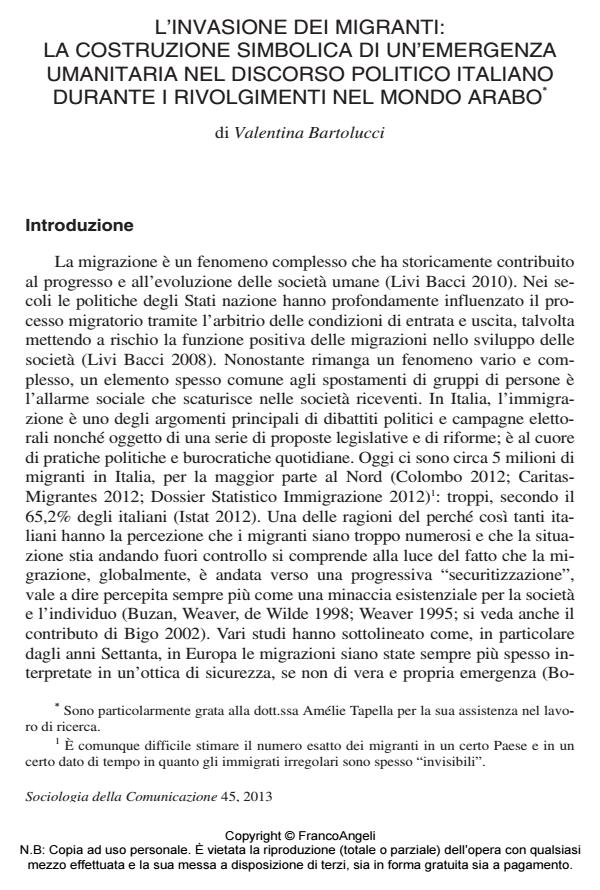The Invasion of Migrants: The Symbolic Construction of a Humanitarian Emergency in the Political Discourse during the Upheavals in the Arab World
Journal title SOCIOLOGIA DELLA COMUNICAZIONE
Author/s Valentina Bartolucci
Publishing Year 2014 Issue 2013/45
Language Italian Pages 22 P. 60-81 File size 559 KB
DOI 10.3280/SC2013-045005
DOI is like a bar code for intellectual property: to have more infomation
click here
Below, you can see the article first page
If you want to buy this article in PDF format, you can do it, following the instructions to buy download credits

FrancoAngeli is member of Publishers International Linking Association, Inc (PILA), a not-for-profit association which run the CrossRef service enabling links to and from online scholarly content.
This paper looks at the symbolic construction of a humanitarian emergency connected to the migration from North Africa that resulted from the outbreak of the Arab uprisings. It seeks to examine some of the properties of the Italian State discourse on migration during the Berlusconi Administration as embedded in legal and administrative procedures. The discourse is analyzed at the level of legal and administrative procedures designed to effectively manage migrations as well as control measures considered appropriate to manage the crisis. The period of analysis goes from December 17, 2010, the conventional start date of the so-called Jasmine Revolution in Tunisia, to the dismissal of the government of Silvio Berlusconi in November 12, 2011. Parallel to the textual analysis of the phenomenon of migration as a top security concern for the government and of migrants as a social menace, this paper also looks at the socio-political effects of this threat construc- tion, including increased surveillance practices and forced repatriation justified in the name of security. The theoretical framework for the analysis is a multidisciplinary Critical Discourse Analysis approach relating discursive and socio-political aspects of the Italian political discourse on migration in the aftermath of the Arab uprisings and the effects of it in the day-to-day policy procedures.
Keywords: Political discourse, migration, Arab uprising, Critical Discourse Analysis, Italian politics, socio-political effects.
Valentina Bartolucci, L’invasione dei migranti: la costruzione simbolica di un’emergenza umanitaria nel discorso politico italiano durante i rivolgimenti nel mondo arabo in "SOCIOLOGIA DELLA COMUNICAZIONE " 45/2013, pp 60-81, DOI: 10.3280/SC2013-045005